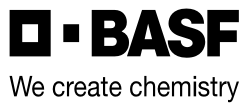Nexicor
Group 3, 7 & 11
For control of the toughest leaf diseases in cereals and blackleg in canola.
- Enhanced, broad-spectrum control of key cereal leaf diseases, including rust, septoria and tan spot
- High-level control of blackleg in canola
- Builds on proven Plant Health Benefits1 to increase growth efficiency and help better manage minor stress, leading to greater yield potential2
- Combines three powerful modes of action, including the unique mobility of Xemium®, for more consistent and continuous control
Labels & SDS
6 AVAILABLE
Applicable On

Canola
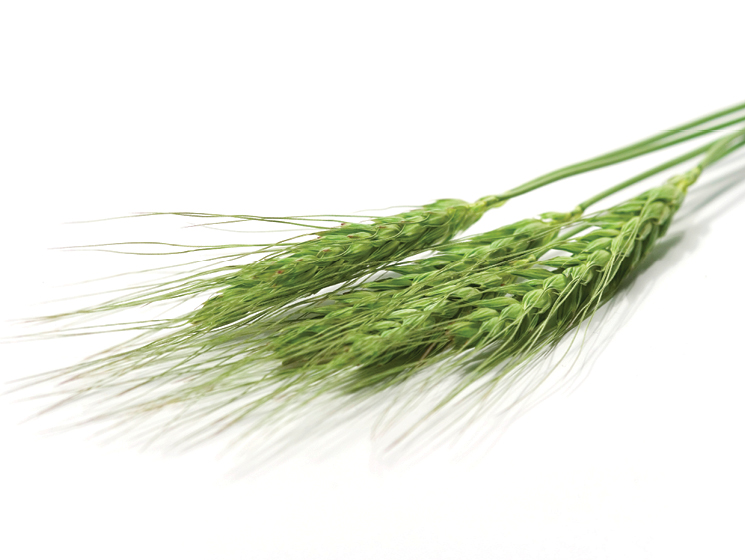
Cereals
Labels & MSDS
Additional Resources
Benefits of Nexicor
- Nexicor combines Group 11 pyraclostrobin, Group 7 Xemium and Group 3 propriconazole for broad-spectrum lead disease control using multiple modes of action
- A portion of Xemium is rapidly absorbed and transported to the tips of the leaves, while the rest binds to the leaf’s surface, creating depots for continuous release
- By inhibiting germination, mycelial growth and sporulation, Nexicor offers both protective and curative-eradicative activity; however, a planned preventative application is the most effective disease management strategy
Performance Trials
A greener cereal crop with Nexicor® fungicide
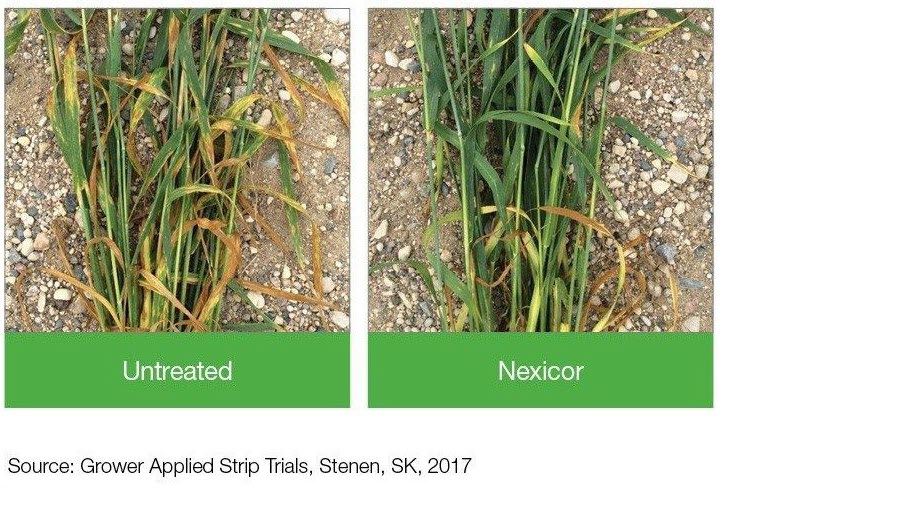
Increased yield potential at high disease pressure in cereals

Increased yield potential at low disease pressure in cereals

Effective control of diseases in barley
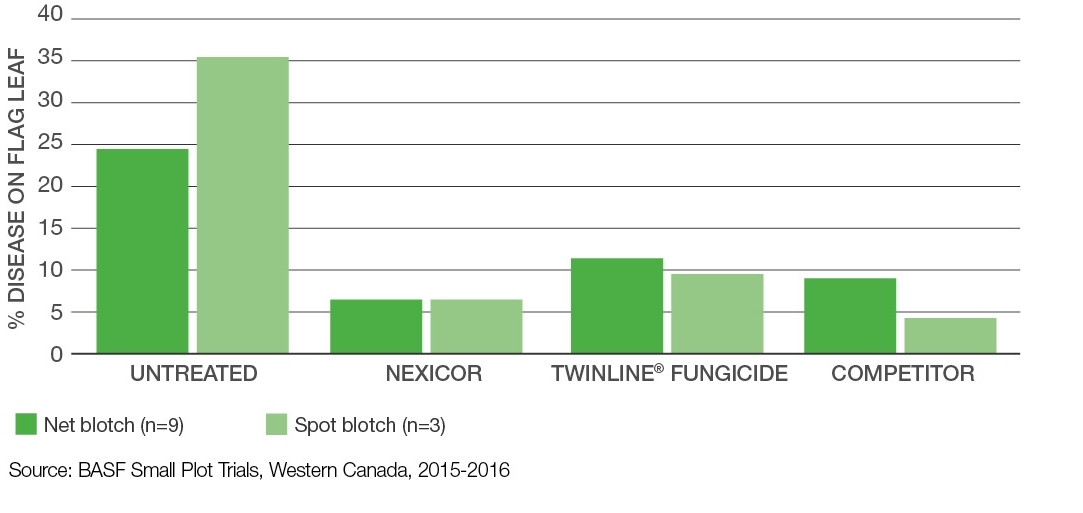
Effective control of diseases in oats
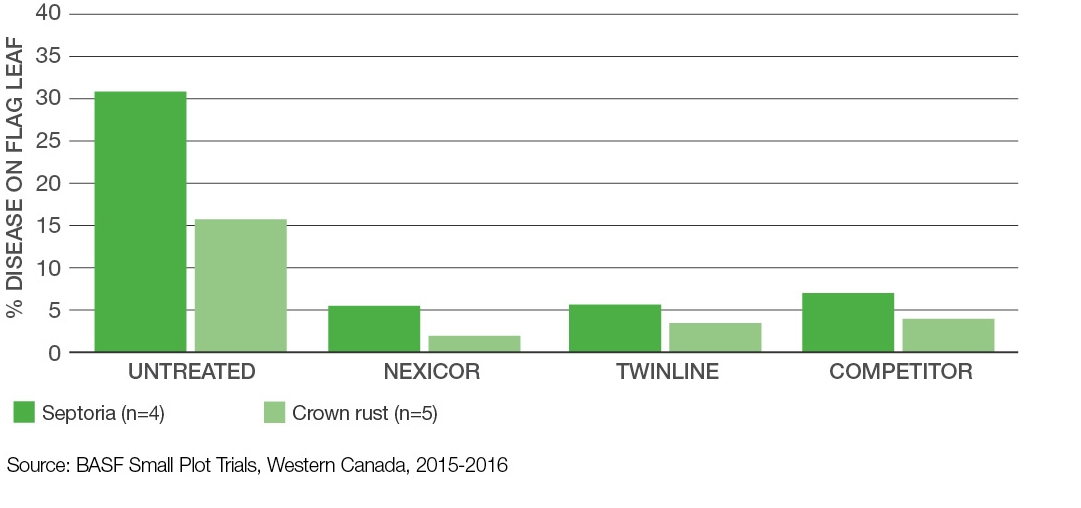
Increased early-season disease control in canola

Product Info & Application Guide
Disease Management
Crop |
Disease |
|---|---|
Barley |
Net blotch (Pyrenophora teres) Scald (Rhynchosporium secalis) Stripe rust (Puccinia striiformis) Spot blotch (Cochliobolus sativus) |
Canola |
Blackleg (Leptosphaeria maculans) |
Oats |
Crown rust (Puccinia coronata) Septoria leaf blotch (Septoria avenae) |
Rye |
Leaf rust (Puccinia recondita) Powdery mildew (Erysiphe graminis f. sp. tritici) |
Wheat (all types) and triticale |
Leaf rust (Puccinia recondita) Powdery mildew (Erysiphe graminis f. sp. tritici) Septoria leaf spot (Septoria tritici or Leptosphaeria nodorum) Stripe rust (Puccinia striiformis) Spot blotch (Cochliobolus sativus) Tan spot (Pyrenophora tritici-repentis) |
Application Tips
Rainfastness - 1 hour.
Nexicor can be applied from stem elongation (GS 31) until early head emergence (GS 55) in cereals. For best results, apply prior to disease development or at the onset of symptoms. For optimal disease control and Plant Health Benefits1, apply at flag-leaf.3
- Do not apply during periods of dead calm, gusty winds or conditions conducive to spray drift. Use the minimum water volumes and ensure thorough coverage of foliage.
- For cereals, do not apply more than 2 applications of any fungicide containing a Group 11 or Group 7 active ingredient per season.
- For canola, do not follow up with a Group 11 fungicide as the first subsequent fungicide treatment if additional applications are required.
When to Apply
| Crops | Staging |
|---|---|
| Barley, oats, rye, triticale, wheat (all types) | stem elongation to early head emergence3 |
| Canola | 2 to 6 leaf (rosette) |
1 Plant Health Benefits refer to products that contain the active ingredient pyraclostrobin.
2 All comparisons are to untreated, unless otherwise stated.
3 While Nexicor fungicide can be applied between stem elongation and early head emergence (GS 31-55), research suggests that applying at flag-leaf (GS 37-39) helps maximize yield potential in cereals.
How Much to Apply
One case of Nexicor fungicide treats 80 acres.
One shuttle treats 640 acres.
| Barley, canola, oats, rye, triticale, wheat | 202 ml/ac (500 ml/ha) |
Water volume
| Ground application | 40 L/ac (10 gal/ac) |
| Aerial application | 20 L/ac (5 gal/ac) |
Mixing order
- Fill the spray tank ½ full of water and start agitation.
- Add the required amount of Nexicor fungicide to the tank.
- If tank mixing, add the required amount of the tank-mix partner.
- Continue agitation while filling the remainder of the spray tank.
Pre-harvest interval
30 days after application for canola.
45 days after application for barley, oats, rye, triticale, wheat.
Tank Mixes
Herbicides for canola: Ares®4, Liberty®5, glyphosate6
Refer to label for cereals.
Contact your local BASF AgSolutions® Grower or Retail Representative or call AgSolutions Customer Care at 1-877-371-BASF (2273) for additional information on supported tank mixes.
4 For Clearfield® canola only.
5 For glufosinate-tolerant canola varieties.
6 For glyphosate-tolerant canola varieties.
FAQ
What is the ideal temperature for storing fungicides and what is the freezing point?
The ideal temperature for storing fungicides is above the freezing point at 0°C. See page 228 in the Agricultural Solutions Guide.
When is the best time to apply fungicide on my crop?
Nexicor® fungicide should be applied early at the 2 to 6 leaf stage.
Lance® and Cotegra® fungicides should be applied at the 20-50% flowering stage.
What are the best practices for storing fungicides?
- Store the leftover product in original tightly closed container. Protect from freezing.
- DO NOT ship or store the product near food, feed, seed and fertilizers.
- Store the product in a cool, dry, locked, well-ventilated area without a floor drain.
Where can I find the tank cleaning recommendations?
Tank clean out recommendations can be found on the product label.
What are the differences between Cotegra®, Lance® and Nexicor® fungicides?
Each fungicide has one or more unique mode(s) of action, controls a different disease(s) and is applied at specific crop staging.
Nexicor fungicide controls blackleg and contains three active ingredients, including Group 3,7 and 11. It can be applied early at the 2 to 6 leaf stage.
Lance fungicide contains a Group 7 active ingredient and controls alternaria black spot and sclerotinia. Cotegra fungicide contains Group 7 and 3 active ingredients and controls sclerotinia in canola. Both of these fungicides can be applied at the 20-50% flowering stage.
Are there any registered follow crops for Cotegra®, Lance® and Nexicor® fungicides?
No, there are no registered follow crops for Cotegra, Lance and Nexicor fungicides.
What is the correct mixing order? (tank mixes with herbicides, fungicides, insecticides, surfactants)
Mixing order for Nexicor® fungicide:
- Fill the spray tank 1/2 full of water and start agitation.
- Add the required amount of Nexicor fungicide to the tank.
- If tank mixing, add the required amount of the tank-mix partner.
- Continue agitation while filling the remainder of the spray tank.
What are the application tips for using Nexicor® fungicide?
- Rainfastness is 1 hour.
- Do not apply during periods of dead calm, gusty winds or conditions conducive to spray drift. Use the minimum water volumes and ensure thorough coverage of foliage.
- For canola, do not follow up with a Group 11 fungicide as the first subsequent fungicide treatment if additional applications are required.
What are the recommended water volumes and application rates for fungicides?
For aerial applications, the recommended water volume for all fungicides is 20 L/ac (5 gal/c). For ground applications with Lance® or Nexicor® fungicides, the recommended water volume is 40 L/ac (10 gal/c). Whereas for ground application with Cotegra® fungicide, the recommended water volume is 40 to 80 L/ac (10 to 20 g/ac). Higher water volume is recommended for optimal coverage.
Which fungicide can I apply to help control blackleg in canola?
You can apply Nexicor® fungicide for high-level control of blackleg in canola. It combines three powerful modes of action (Group 11, 7 & 3), including the unique mobility of Xemium®, for more consistent and continuous control.
What is the optimal crop staging when applying Nexicor® to cereals?
Fungicide performance is optimal when Nexicor is applied prior to disease development or at the onset of disease symptoms. Foliar disease symptoms may occur at any time; crop scouting is essential for assessing disease risk. Nexicor is registered for application from stem elongation (GS31) until early head emergence (GS55) on cereal crops.
To maximize yield in cereals, it is important to protect the flag leaf from disease. Therefore, the optimum time to apply Nexicor is immediately after flag-leaf emergence (GS 37-39).
How do I determine the best timing for a fungicide application on my cereals (i.e. flag-leaf timing vs. heading)?
To determine the best time to apply a fungicide, you must determine your risk levels and production goals.
In wheat, 65% of yield potential is built by the last two leaves. That's why growers see the most consistent return by planning a preventative fungicide application on their cereals at flag-leaf.1 A planned application of Nexicor® consistently provides industry-leading performance and a positive return under high and low foliar disease pressure.2
If you are at risk of fusarium head blight (FHB), BASF recommends an application of Caramba® fungicide at 20% flowering (GS 61-63). Caramba can help reduce deoxynivalenol (DON) contamination and preserve grade quality. Caramba also provides an extended window for effective control of later-season foliar diseases.
1 While Nexicor fungicide can be applied between stem elongation and early head emergence (GS 31-55), research suggests that applying at flag-leaf (GS 37-39) helps maximize yield potential in cereals.
2 AgSolutions® Performance Trials, Western Canada 2016-2017
How many days of control can I expect from Nexicor® fungicide?
The length of time a fungicide can provide disease control is highly dependent on environmental conditions. With three modes of action, Nexicor has an increased level of disease control when compared to our leading competitors.1 Nexicor inhibits spore germination in addition to mycelial growth and sporulation of susceptible fungi on the leaf surface, acting both preventatively and curative-eradicatively to provide control throughout the fungal growth stages. The unique mobility of Xemium® helps deliver more consistent and continuous control.
1 RCD Trials, Western Canada, 2015-2016
